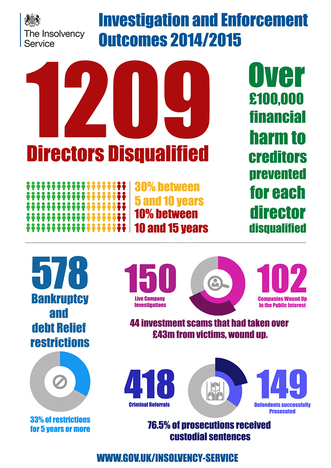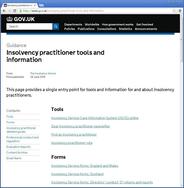 Some 10% of director disqualifications are for more than 10 years but what sort of conduct leads to the highest tariff bans? This can vary widely according to the facts of each case as the recent cases we outline below demonstrate.
A recurring reason why a director can find themselves on the wrong end of a high tariff ban is involving their company in a VAT fraud. One director of a mobile phone and computer component wholesaler was disqualified for 13 years for engaging in a scheme linked to VAT fraud and making wrongful VAT reclaims against HM Revenue & Customs, resulting in a claim in the liquidation proceedings by HMRC of over £91 million.
Other forms of scams can also result in long bans, as in the land banking scam operated by a director through three companies in which members of the public were misled into parting with at least £1.7 million for small plots of land of little value. This resulted in his disqualification for 14 years. However it is not only scams that lead to high tariff disqualifications.
Other directors who face long bans include those who fail to promote the interests of their company, such as the ex-director of a football club disqualified for the maximum 15 years for failing to avoid conflict of interest in the running of the club. Flouting a previous disqualification can also result in a high tariff ban, as well as a custodial sentence. Two disqualified directors were sentenced to a combined 13 months in prison, and disqualified for a further 12 years each, for being in control of a company while banned from doing so.
Falsifying information and misappropriating company funds can also be factors in top bracket tariff disqualifications. Two directors of a failed training services provider were disqualified for 12 years after the company was found to have falsified student information to get nearly £200,000 of public funds. The director of two construction companies was banned for 13 years for misappropriating £830,534 of company monies.
Worthy of a final mention was the accountant banned for 11 years for failing to keep proper accounting records or deal with the tax affairs of both his companies.
While the reasons why a director may be disqualified for a long period are many and various, we look at the facts of every case and will pursue those cases that merit it, no matter how complex they might be.
Back to Top
|
The regulatory landscape for the insolvency profession will
start to look very different following the decision by three current regulators
to relinquish their role. The Solicitors Regulatory Authority, the Law Society
of Scotland and the Insolvency Service have all announced plans to move away
from insolvency practitioner authorisation in the near future. That will reduce
the number of regulators an insolvency practitioner can choose to be authorised
by from eight to five recognised professional bodies. The number of IPs is
unlikely to reduce significantly, as most of those currently authorised by one
of the departing bodies will in all likelihood choose to transfer to another
regulator. There are currently around 1,700 authorised insolvency practitioners,
of whom around 1,300 actively take appointments.
The remaining regulators will remain subject to oversight
by the Insolvency Service, which has the role of ensuring they continue to
operate effectively. Our role will be bolstered by the new powers introduced by
the Small Business, Enterprise and Employment Act 2015, which for the first
time set regulatory objectives for the regulators. The Act also gave the
Insolvency Service a proportionate range of sanctions to apply to any recognised
professional body found to be in breach of those objectives, bringing us into
line with other regulators in the financial services sector. We will shortly be
publishing guidance on how we intend to monitor the regulatory objectives and
apply sanctions.
Sanctions imposed by regulators against
individual insolvency practitioners are now
published on the Insolvency Service website. Recent examples include a £15,000
fine and severe reprimand for an insolvency practitioner found to have breached
the code of ethics by accepting an appointment where there was a clear conflict
due to her firm’s earlier involvement with the insolvent company.
We also continue to publish monitoring reports on the
authorising bodies: our most recent report was on the Institute of Chartered Accountants of
Scotland’s authorisation of insolvency practitioners.
Back to Top
 Responses to a call for evidence issued in February on the UK insolvency regime demonstrate that our framework encourages out of court procedures, with minimum court involvement, and focuses on business recovery. The Insolvency Service sought views from industry experts and other interested parties on how the UK regime works to contribute to a review being conducted by the European Commission. The Commission is considering a new approach to business failure and insolvency targeting efficient restructuring of viable enterprises in financial difficulty and a second chance for honest entrepreneurs. Responses received to the call for evidence and the UK submission to the review have been published on our website.
Back to Top
|
A final draft of the forthcoming Insolvency Rules 2016 has been
delivered to the Insolvency Rules Committee. The draft rules update the
existing framework as part of a modernisation project and to take forward
policy changes under various pieces of primary legislation. You can read the
rules and an explanatory note of the policy changes on our website. The Insolvency Rules Committee are now reviewing the changes and
will report to the Lord Chancellor who is responsible for making these rules.
Subject to this work, it is anticipated that the Rules will be made in Spring
2016, with provisions relating to the new adjudicator's office coming into force on 6 April 2016 and the remainder on 1 October 2016.
Back to Top
 We have created a page on our website providing a single entry point for insolvency practitioners. This page brings together all the tools, forms, guides and other types of information that are relevant for insolvency practitioners. Please email us, using 'Insolvency Practitioner Information' in the subject line, if you have any feedback on this page.
Back to Top
|
 From 1 September 2015, the opening hours of the Insolvency Enquiry Line will change to 9am - 5pm Monday to Friday. A review of line activity found that comparatively few calls are received between the hours of 8am and 9am, and the new hours will enable us to provide a better service to customers by concentrating resources and reducing waiting time during busier peak hours.
The Insolvency Enquiry Line provides information about insolvency legislation and procedures, including details of the official receivers and redundancy payments offices. The team cannot provide advice on case-related matters but will provide information based on the current insolvency legislation and related procedures and processes.
Until 1 September 2015 hours remain 8am - 5pm, Monday to Friday. You can call the Insolvency Enquiry Line on 0300 678 0015.
Back to Top
|
The Insolvency Service has published its annual plan, which sets out our targets and priorities for the year 2015/16. During
this year we plan to introduce a number of key changes, including online
portals for both bankruptcy petitions and redundancy payments applications to
improve our services.
Recently our Chief Executive, Sarah Albon, spoke about
plans for the future and her priorities for the agency. You can view a video of
the speech as part of our podcast series on our YouTube channel; closed
captioning is available.
Back to Top
19 August: Quarterly enforcement outcomes statistics,
April to June 2015
29 October: Quarterly insolvency statistics, July to
October 2015
Back to Top
If you have any feedback on
this newsletter or other issues please email
us.
Back to Top
|